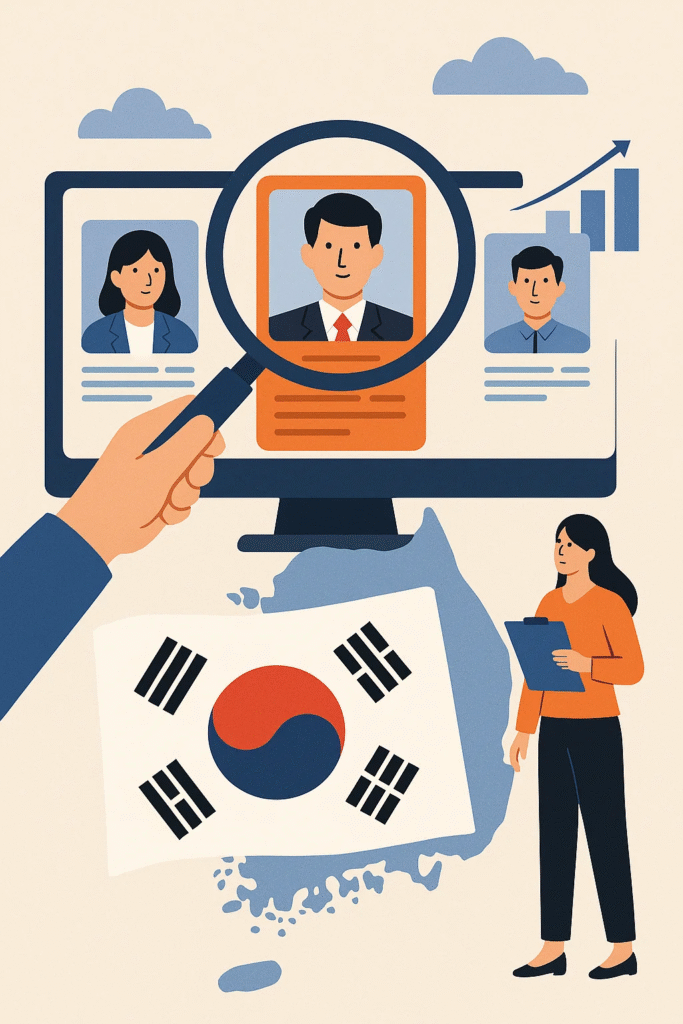Key Takeaways
- South Korea’s recruitment market in 2025 is driven by high demand for skilled talent in AI, cybersecurity, and healthcare sectors.
- Remote work and digital recruitment tools are reshaping the hiring process, offering greater flexibility for both employers and job seekers.
- Employers face challenges in navigating labor regulations and a shrinking workforce, while job seekers must focus on in-demand skills and continuous learning.
The recruitment and hiring landscape in South Korea has undergone significant transformation in recent years, driven by technological advancements, shifting labor market dynamics, and changing societal expectations.
As we enter 2025, the state of recruitment in South Korea presents an evolving picture, one that reflects both global trends and unique local factors.
From the rise of artificial intelligence (AI) in recruitment processes to the growing emphasis on work-life balance, South Korea’s hiring practices are adapting to the demands of a highly digitalized and increasingly diverse workforce.

In 2025, South Korea’s recruitment landscape is marked by a highly competitive job market, where employers are keen to attract the best talent, particularly in high-demand sectors such as technology, finance, and healthcare.
However, this talent pool is not just limited to local professionals.
As globalization continues to shape South Korea’s economy, companies are also focusing on attracting international candidates with specialized skills, leading to an increased emphasis on diversity and inclusion in the hiring process.
Moreover, South Korea’s demographic challenges, particularly its aging population and low birth rates, have profound implications for the labor market.
With a shrinking working-age population, employers are increasingly relying on automation, AI, and other innovative technologies to fill gaps, enhance productivity, and streamline recruitment.
These technological advancements are reshaping the way companies evaluate candidates, with many now using AI-driven tools for tasks such as resume screening, talent sourcing, and even conducting initial interviews.
Simultaneously, the country’s evolving work culture, influenced by both generational shifts and the global rise of flexible work arrangements, is making its mark on the recruitment process.
South Korean employees, especially younger generations, are increasingly prioritizing factors such as work-life balance, career growth opportunities, and workplace culture over traditional benefits such as job security or compensation.
As a result, companies are adapting their hiring strategies to align with these changing priorities, offering more flexible work arrangements, remote work options, and opportunities for skill development.
In this blog, we will take a comprehensive look at the current state of recruitment and hiring in South Korea in 2025, exploring the key trends, challenges, and opportunities that shape the hiring landscape.
From technological innovations and labor market shifts to changing workplace expectations and the impact of globalization, we will analyze how these factors are influencing recruitment strategies in South Korea and what employers and job seekers can expect in the years to come.
Whether you are a hiring manager, HR professional, job seeker, or business leader, understanding these trends will be essential for navigating the recruitment landscape in one of Asia’s most dynamic economies.
Before we venture further into this article, we would like to share who we are and what we do.
About 9cv9
9cv9 is a business tech startup based in Singapore and Asia, with a strong presence all over the world.
With over nine years of startup and business experience, and being highly involved in connecting with thousands of companies and startups, the 9cv9 team has listed some important learning points in this overview of The State of Recruitment and Hiring in South Korea in 2025.
If your company needs recruitment and headhunting services to hire top-quality employees, you can use 9cv9 headhunting and recruitment services to hire top talents and candidates. Find out more here, or send over an email to [email protected].
Or just post 1 free job posting here at 9cv9 Hiring Portal in under 10 minutes.
The State of Recruitment and Hiring in South Korea in 2025
- A Comprehensive Overview
- Industry-Specific Hiring Trends and Demands in South Korea in 2025
- Evolution of Recruitment Methods and Technologies in South Korea in 2025
- Salary and Compensation Landscape in South Korea in 2025
- Government Policies and Their Impact on Employment in South Korea in 2025
- Challenges and Opportunities in the South Korean Recruitment Market in 2025
- Future Outlook and Predictions for Recruitment Beyond 2025
- Strategic Recommendations for Employers and Job Seekers in South Korea’s 2025 Recruitment Market
1. A Comprehensive Overview
The recruitment and hiring environment in South Korea in 2025 is shaped by a multitude of factors, including economic growth projections, labor market dynamics, and the country’s unique socio-political landscape. As South Korea faces a challenging economic climate, both employers and job seekers are adjusting their strategies to navigate a labor market marked by uncertainties and evolving trends.
Macroeconomic Context: South Korea’s Economic Landscape in 2025
Economic Growth Projections and Key Influencing Factors
- Moderate Growth Expectations: Economic forecasts for South Korea in 2025 show a moderate growth trajectory, with some downward revisions.
- The OECD initially projected a 2.1% GDP growth in December 2024, but by March 2025, this was revised downward to 1.5%.
- The Bank of Korea projected a slightly higher growth range of 1.6% to 1.7%, though still indicating a slowdown.
- Other organizations, like Morgan Stanley, predicted even more conservative forecasts, with a 1.5% GDP growth due to weak consumer spending, slowing exports, and external risks such as geopolitical instability.
- Key Drivers of Economic Slowdown:
- Global Trade Risks: South Korea’s export-oriented economy is particularly vulnerable to global trade disruptions, such as potential new tariffs or trade restrictions from key partners like the United States.
- Domestic Challenges: Political instability, weak domestic demand, and a shrinking working-age population could further dampen economic growth. The South Korean government’s stimulus plan aims to address these challenges but its impact on job creation remains uncertain.
Unemployment and Labor Force Dynamics in 2025
- Unemployment Trends:
- In March 2025, South Korea’s unemployment rate stood at 3.1%, marking a slight increase of 0.1% from the previous year. This reflects a growing caution in the job market.
- The seasonally adjusted unemployment rate for March 2025 was slightly lower at 2.9%, indicating that despite some fluctuations, the overall unemployment trend remains relatively stable.
- Labor Force Participation:
- The labor force participation rate reached 64.6% in March 2025, reflecting a positive trend as more people are entering the workforce. This figure represents the highest participation rate recorded for the month of March.
- The employment rate for individuals aged 15 and above rose to 62.5%, which was also a record high. However, the increase in the labor force is outpacing job creation, which could lead to challenges in employment rates.
Youth Unemployment and Temporary Employment Trends
- Youth Unemployment:
- Youth unemployment continues to be a significant issue, with the unemployment rate for individuals aged 15 to 29 reaching 7.0% in February 2025.
- This high unemployment rate may be attributed to a mismatch between the skills of younger workers and the demands of the labor market, or employers’ preference for more experienced candidates.
- Rise in Temporary Employment:
- A noticeable increase in temporary employment was observed, with a 2.7% rise in March 2025 compared to the same period in 2024.
- Employers appear to be adopting more flexible workforce strategies, opting for temporary workers over permanent hires due to the uncertain economic climate.
The Impact of Political and Economic Uncertainties on Recruitment
Political Instability and Domestic Demand
- South Korea’s political instability in early 2025 is expected to dampen both consumer and business confidence, impacting domestic spending and investment.
- This uncertainty could cause employers to be more cautious in their hiring decisions, especially for long-term roles.
Export Dependency and Trade Risks
- As an export-driven economy, South Korea faces substantial risks from potential shifts in global trade policies.
- Increased tariffs or trade restrictions, particularly from the United States, could result in decreased demand for South Korean goods, which would affect key sectors such as electronics and automobiles, leading to potential job losses.
Manufacturing Sector Sentiment
- The manufacturing sector remains a cornerstone of South Korea’s economy, but current sentiment within the sector is notably pessimistic.
- The Business Survey Index (BSI) for South Korea’s top 1,500 manufacturing companies was recorded at 88 for the first quarter of 2025, indicating that pessimists outnumber optimists regarding the near-term business outlook.
- This cautious outlook could lead to reduced investment in workforce expansion, limiting job opportunities in the manufacturing industry.
Government Response and Policy Measures
Stimulus Plans and Job Creation Initiatives
- In response to the challenging economic landscape, the South Korean government unveiled a substantial stimulus plan in early 2025, amounting to 431.1 trillion won.
- The primary goal of this stimulus is to boost domestic demand and stimulate job creation, particularly in sectors most affected by the economic slowdown.
- However, the success of these measures in alleviating the negative impacts of the global uncertainties and structural issues like the aging population remains uncertain.
Conclusion: Navigating Recruitment and Hiring Challenges in 2025
As South Korea enters 2025, the recruitment and hiring landscape reflects a complex interplay of economic slowdown, political uncertainties, and labor market dynamics. For employers, this means a need to adopt more flexible and cautious hiring strategies, particularly in sectors most exposed to global risks. For job seekers, navigating this environment will require adaptability, continuous skill development, and a keen awareness of the shifting demands within the job market.
Understanding the factors shaping recruitment trends in South Korea will be essential for both employers and candidates as they adjust to the evolving challenges and opportunities in the job market. Whether through embracing new technologies, expanding into international talent pools, or responding to shifts in work culture, the future of recruitment in South Korea remains a landscape of both opportunity and caution.
2. Industry-Specific Hiring Trends and Demands in South Korea in 2025
In 2025, South Korea’s job market is shaped by sector-specific demands that reflect both global trends and the nation’s strategic priorities. Several industries are experiencing substantial growth, each presenting unique opportunities for skilled professionals. The following sections break down the key industries driving recruitment and the specific roles in high demand across the country.
Most In-Demand Industries in South Korea in 2025
Technology and IT Sector
- Sector Overview: The Technology and IT industry continues to be one of South Korea’s most prominent drivers of job growth. This sector is projected to contribute 25% to the nation’s GDP in 2025, underscoring its central role in the economy.
- Key Demand Drivers:
- Digital Transformation: Many industries are undergoing rapid digitalization, fueling the need for tech professionals across various domains.
- Government Investment: Significant public sector investment in technologies such as Artificial Intelligence (AI), cybersecurity, and cloud computing is creating strong demand for skilled workers.
- High-Value Roles: Key areas of growth include AI development, cybersecurity, cloud computing, and digital infrastructure. The rise of AI, machine learning, and data analytics is significantly shaping the demand in this sector.
Healthcare and Biotechnology
- Sector Overview: South Korea’s aging population and the government’s strong focus on enhancing healthcare and biotechnology capabilities have made this sector increasingly important in 2025.
- Key Demand Drivers:
- Aging Population: The increasing number of elderly citizens is putting pressure on healthcare systems, driving demand for healthcare professionals across various disciplines.
- Research and Infrastructure: Investment in biotech research, particularly in cancer treatments and regenerative medicine, is expanding the need for highly skilled professionals.
- Focus Areas: Areas such as biotechnology research, pharmaceutical development, and healthcare IT are crucial to the sector’s growth.
Manufacturing and Engineering
- Sector Overview: Despite the overall slowdown in hiring across other sectors, South Korea’s manufacturing and engineering industry remains a vital employer, particularly in high-tech and sustainable sectors.
- Key Demand Drivers:
- Smart Factory Technologies: The ongoing adoption of automation and smart technologies is creating a need for specialized engineers.
- Green Energy: As South Korea focuses on renewable energy solutions and sustainable manufacturing processes, engineers with expertise in these areas are in high demand.
- Key Industries: The electronics, automobile, and green energy sectors are key contributors to demand for skilled engineers and technicians.
Finance and Fintech
- Sector Overview: The finance sector, particularly the fintech segment, is experiencing rapid growth, with a shift towards digital banking and online financial services.
- Key Demand Drivers:
- Digital Banking Growth: The rise of digital and mobile banking platforms has led to increased hiring in fintech companies.
- Blockchain and Data Analysis: Blockchain technology, mobile payments, and financial data analytics are key areas driving recruitment in this space.
- Expanding Digital Presence: Traditional financial institutions are increasingly focusing on enhancing their digital platforms, creating demand for tech-savvy professionals in finance.
Specific Job Roles Experiencing High Demand in 2025
As industries grow, certain job roles within these sectors are seeing particularly high demand. These positions reflect both technological advancements and sector-specific needs that require specialized expertise.
Technology Sector
- AI and Machine Learning Engineers: Skilled professionals who can develop and implement AI-driven solutions are in high demand as businesses seek to integrate automation and intelligent systems into their operations.
- Cybersecurity Specialists: Given the increasing frequency of cyberattacks, companies are urgently seeking professionals to protect their digital infrastructure and ensure data security.
- Backend and Front-end Developers: These professionals are needed to build, maintain, and optimize websites and applications, driving digital transformation across industries.
- Cloud Security Experts: With the rise of cloud computing, roles focused on securing cloud-based systems and managing digital data are critical.
- Data Architects: Professionals who can design and implement data management systems are highly sought after, especially as data becomes a more valuable resource for businesses.
Healthcare Sector
- Biotech Researchers: The need for advanced research in biotechnology, particularly in areas like cancer treatment and regenerative medicine, has led to increased demand for skilled researchers.
- Pharmaceutical Specialists: The pharmaceutical sector is seeking professionals to assist in the development and production of new drugs, particularly those aimed at treating chronic and age-related conditions.
- Healthcare IT Professionals: With healthcare becoming more digital, roles focused on managing and analyzing healthcare data are essential to support the transition to digital health systems.
Manufacturing and Engineering Sector
- Mechanical Engineers: These professionals are needed to design and optimize machinery and systems, particularly within industries like electronics and automobile manufacturing.
- Robotics Experts: As smart factory technologies take hold, companies require experts to design, implement, and maintain robotic systems for automated production lines.
- Industrial Engineers: These specialists are crucial for streamlining production processes, improving efficiency, and reducing waste within manufacturing operations.
- Electric Vehicle and Renewable Energy Engineers: As South Korea increasingly focuses on sustainable energy, engineers specializing in electric vehicles and renewable energy technologies are in high demand.
Conclusion: Navigating Industry-Specific Job Opportunities
South Korea’s recruitment landscape in 2025 offers a diverse range of opportunities across multiple high-demand industries. Technology, healthcare, manufacturing, and finance are at the forefront of the job market, each offering unique roles for specialized professionals. Companies across these sectors are looking to fill positions that align with technological advancements, sustainability goals, and digital transformation trends.
Job seekers aiming to succeed in South Korea’s competitive labor market will need to focus on gaining expertise in the specific skills required by these rapidly growing industries. Understanding the key roles driving demand will be essential for navigating the job market and securing rewarding career opportunities. With significant investment and growth expected in these sectors, the coming years are set to offer a wealth of job prospects for those with the right skills and expertise.
3. Evolution of Recruitment Methods and Technologies in South Korea in 2025
The landscape of talent acquisition in South Korea is undergoing a profound shift as technological advancements and changing work cultures redefine recruitment methods. The year 2025 is seeing significant changes, with companies embracing new strategies to attract, engage, and hire talent. This evolution is primarily driven by the need to adapt to global changes, technological disruptions, and a rapidly changing workforce. Key trends include the rise of digital recruitment tools, increased international talent acquisition, and the focus on skills rather than traditional qualifications.
Current Trends in Talent Acquisition
Remote Work and Digital Collaboration
- Increased Adoption: Many South Korean companies, particularly in industries like technology, marketing, and consulting, have embraced remote work as a standard practice. This shift provides flexibility for employees and helps employers access a global talent pool, broadening recruitment horizons.
- Flexible Work Culture: Employees now have more control over their work schedules and locations, contributing to better work-life balance, which has become a top priority for many job seekers.
- Broader Talent Pool: Remote work enables companies to hire talent from outside South Korea, including from countries with specialized skill sets, particularly in tech, further enhancing workforce diversity.
Skills Over Academic Credentials
- Shift in Priorities: Employers are increasingly focusing on practical skills rather than relying on formal educational qualifications. In sectors like technology, where innovation evolves rapidly, this trend is gaining momentum.
- Skill-Based Hiring: Companies now seek candidates with demonstrated expertise in specific technical areas, such as coding, software development, cybersecurity, and artificial intelligence (AI), rather than simply looking for graduates from prestigious universities.
- Competency-Based Evaluation: Employers are using skills assessments, certifications, and practical work experience to gauge a candidate’s ability to perform rather than focusing on traditional academic paths.
Active Recruitment of International Talent
- Global Talent Acquisition: South Korean companies, particularly in technology fields like AI, cybersecurity, and cloud computing, are increasingly hiring skilled professionals from abroad to address the growing talent shortage.
- Support for Relocation: Companies offer attractive relocation packages, including compensation for moving expenses and support with visas, to attract top international candidates.
- Diverse Talent Pool: With South Korea’s aging population and the need to keep pace with rapid technological advancements, international talent is seen as a vital solution to bridging skill gaps.
The Role of Digital Recruitment Tools and AI
Enhanced Recruitment via Job Portals
- Job Portals with AI Integration: Platforms like 9cv9, a leading job portal in South Korea, leverage AI and machine learning technologies to streamline the hiring process. By analyzing both job descriptions and candidate profiles, these platforms improve the matching process, helping companies find the right fit more efficiently.
- Wider Reach: Major portals such as JobKorea, Saramin, and 9cv9 are continuously evolving to offer features like automated candidate screening, skill-based filtering, and tailored job recommendations, reducing hiring time and costs.
Virtual Job Fairs and Online Assessments
- Virtual Job Fairs: South Korean companies are increasingly using virtual job fairs to connect with potential candidates across the globe. These online events make it easier to attract diverse talent and engage with candidates in remote locations, expanding the reach of traditional recruitment events.
- Online Assessments: Online testing platforms, which allow companies to assess candidates’ skills remotely, have become vital, especially for positions that can be filled virtually. This trend is beneficial for positions requiring specialized knowledge, such as tech or finance roles.
Social Media as Recruitment Tool
- LinkedIn and International Reach: LinkedIn remains one of the most powerful tools for professional recruitment, especially for hiring international talent. It allows companies to network with global professionals and build relationships within specific industries.
- Targeted Advertising: Social media platforms such as Instagram and Facebook are gaining traction in recruiting younger candidates for creative or entry-level positions. Through targeted ads and direct engagement, these platforms help companies reach demographic groups they might otherwise miss.
Effectiveness of Various Recruitment Channels
Online Job Portals
- Primary Recruitment Resource: Platforms like 9cv9 and JobKorea continue to be essential in the South Korean job market. They cater to a wide array of roles, from entry-level to senior positions, across various industries. These portals are integral for both employers and job seekers in finding and applying for positions.
- Specialized Search Features: These portals offer specific search filters to refine candidate search based on location, skill set, and job experience, ensuring that companies can quickly identify the most relevant applicants.
Recruitment Agencies and Headhunters
- Niche and Executive Roles: Recruitment agencies, including 9cv9 Recruitment Agency, are crucial for filling highly specialized or executive-level roles. They leverage extensive networks and industry expertise to find the best candidates for top-tier positions.
- Expertise in Matching: Headhunters bring in-depth knowledge of the job market and a strong understanding of employer needs, ensuring a better fit for high-stakes or niche roles.
Campus Recruitment and Internships
- University Partnerships: Campus recruitment continues to be an effective strategy for companies seeking talented graduates from South Korea’s top universities. Companies often engage in job fairs and internship programs to cultivate young talent and create a direct pipeline to full-time employment.
- Internships as Talent Pipeline: Offering internships is a well-established way for companies to identify and nurture young professionals, allowing both the employer and the candidate to evaluate fit before making long-term employment decisions.
Employee Referral Programs
- Cultural Fit: Employee referral programs remain a key channel for recruitment. Recommendations from existing employees help employers find candidates who are likely to fit the company culture and align with the organization’s values and goals.
- Cost-Effective Hiring: These programs tend to be more cost-effective than traditional recruitment methods, as they bypass advertising and agency fees. Additionally, referred candidates often have a higher retention rate.
Networking and Industry Events
- Building Relationships: Networking remains an essential part of recruitment in South Korea. By participating in industry events and conferences, employers can build relationships with prospective candidates and gain insights into emerging talent pools.
- Industry-Specific Events: Participating in events specific to an industry—such as tech or finance—allows companies to directly engage with professionals who have the precise skills needed.
Freelancers and Contractors
- Flexible Workforce: Freelancers and contractors provide an increasingly popular solution for companies that need specialized expertise on a temporary or project basis. Collaborating with freelancers gives employers a chance to assess a candidate’s skills and work ethic before committing to a full-time employment offer.
- Test for Fit: Freelancers often provide a ‘trial run’ of their capabilities, giving companies more flexibility to assess long-term suitability without a permanent commitment.
Conclusion
In 2025, recruitment in South Korea is being reshaped by technology, shifting work cultures, and evolving economic needs. Companies are adopting advanced digital tools like AI-powered job portals, participating in virtual job fairs, and focusing more on skills rather than traditional academic qualifications. International talent acquisition is also gaining momentum, particularly in industries like technology and healthcare, where skill gaps are pronounced.
For job seekers and employers alike, leveraging digital platforms like 9cv9, which integrates modern AI features for smarter recruitment, is becoming increasingly essential. Traditional channels such as recruitment agencies, campus hiring, and networking also remain relevant, providing a multi-faceted approach to talent acquisition. The job market in South Korea in 2025 is dynamic and offers exciting opportunities for both companies and candidates to thrive in a competitive environment.
4. Salary and Compensation Landscape in South Korea in 2025
In 2025, South Korea’s salary and compensation landscape is being significantly shaped by the demand for skilled professionals in key sectors like technology, healthcare, and finance. As industries continue to evolve, salary ranges for high-demand roles reflect the growing competition for talent, as well as the increasing specialization of skills. Understanding these dynamics is crucial for both employers and job seekers navigating the market.
Average Salaries for Key Roles Across Different Sectors
Technology Sector
- AI Engineers:
- Average Salaries: The demand for AI talent continues to escalate, with average annual salaries ranging between ₩89.9 million and ₩107.4 million.
- Senior Roles: Experienced AI Engineers can earn over ₩120 million annually, reflecting the high competition for these specialists.
- Entry-Level: Newcomers to the field can expect salaries between $64,440 and $85,920, while senior professionals can earn between $128,880 and $193,320.
- Demand: The significant investment in AI technologies and their crucial role in driving innovation in various sectors contribute to these high compensation levels.
- Cybersecurity Specialists:
- Average Salaries: These professionals are highly valued for protecting organizations against the ever-present risk of cyber threats. Their average annual salaries range from ₩90 million to ₩96 million, with senior specialists earning over ₩100 million.
- Entry-Level: Starting salaries for junior-level cybersecurity roles begin at ₩58 million annually.
- Senior Roles: Highly experienced specialists may earn up to ₩146,000 annually, reflecting the critical nature of their work in safeguarding digital infrastructure.
- Skills in Demand: The need for specialized cybersecurity knowledge drives competitive pay for these professionals.
- Data Scientists:
- Average Salaries: Data Scientists, with their expertise in data-driven decision-making, earn between ₩90 million and ₩96.3 million annually. Highly experienced professionals can command salaries of up to ₩150 million.
- Entry-Level: New Data Scientists can expect salaries in the range of $57,780 to $77,040.
- Senior-Level: Senior roles can offer salaries between $115,560 and $173,340, particularly in industries that rely heavily on big data analytics.
- Software Engineers:
- Average Salaries: Software Engineers, who form the backbone of the tech industry, earn between ₩50 million and ₩88.4 million annually, depending on their experience, role specialization, and the company they work for.
Healthcare Sector
- General Healthcare Professionals:
- Average Salary: Across the healthcare sector, the average salary is approximately ₩67 million annually, although this varies significantly by role.
- Dentists:
- Average Salary: Dentists earn an average annual salary of around ₩112.4 million, reflecting the specialized nature of their work.
- Medical Doctors:
- Average Salary: Medical Doctors earn an average annual salary of ₩132.8 million, with variations depending on their specialization and experience.
- Hospital Administrators:
- Average Salary: Hospital Administrators, particularly those working in major cities like Seoul, can earn up to ₩222.9 million annually, reflecting their seniority and responsibilities in managing complex healthcare facilities.
- Nurses:
- Average Salary: Nurses, essential to the healthcare system, earn an average salary of approximately ₩3 million monthly, translating to around ₩36 million annually.
Influence of Experience, Skills, and Location on Salary Levels
Experience
- Impact of Experience: In South Korea’s competitive job market, experience plays a critical role in determining salary levels. Professionals with several years of experience are able to command much higher salaries compared to their entry-level counterparts.
- Senior vs. Entry-Level: For instance, senior-level AI Engineers earn more than double the salary of junior-level engineers, emphasizing the importance of experience in salary negotiation.
- Track Record: A strong professional background and proven success in a particular role allow individuals to secure premium compensation packages, particularly in high-demand industries like tech and healthcare.
Skills
- Demand for Specialized Skills: Professionals with expertise in cutting-edge technologies such as artificial intelligence, cloud computing, and cybersecurity are able to negotiate higher salaries due to the talent shortage in these fields.
- High-Value Skills: Proficiency in programming languages like Python, Java, and JavaScript, as well as expertise in AI frameworks and cloud platforms, is highly sought after in the technology sector.
- Certification and Training: Specialized certifications and advanced degrees further enhance an individual’s earning potential in these high-demand sectors.
Location
- Geographical Variations: Salary levels in South Korea are also significantly influenced by the geographical location of the job.
- Seoul vs. Other Regions: Major metropolitan areas like Seoul offer higher salaries, reflecting the increased cost of living and the concentration of leading companies in the region. In Seoul, salaries in the technology sector are reported to be 15-20% higher than in other regions.
- Regional Differences: Similarly, positions in cybersecurity and other specialized fields often come with higher compensation in Seoul compared to other urban centers or rural areas. This is due to the higher demand for talent in these cities and the presence of international companies that offer competitive pay packages.
Conclusion
In 2025, the salary and compensation landscape in South Korea is heavily influenced by the demand for specialized skills, particularly in the technology and healthcare sectors. As companies continue to prioritize roles such as AI Engineers, Cybersecurity Specialists, Data Scientists, and senior medical professionals, salaries are reflecting the critical nature of these roles and the competition for talent. Furthermore, factors such as experience, technical expertise, and location significantly impact salary levels. Professionals who possess in-demand skills or work in major cities like Seoul are positioned to earn higher compensation packages. Employers are increasingly required to offer competitive salaries and benefits to attract and retain top talent in a rapidly evolving job market.
5. Government Policies and Their Impact on Employment in South Korea in 2025
The South Korean government has implemented several strategic initiatives and policy changes in 2025 designed to address the challenges of job creation, economic growth, and workforce development. These policies are especially important in light of the country’s evolving labor market dynamics, where the slowdown in job growth has prompted a proactive governmental response.
Key Government Initiatives in 2025
- Stimulus Package for Economic Recovery:
- In response to the observed slowdown in job growth in 2024, the South Korean government unveiled a substantial stimulus package worth 431.1 trillion won.
- This financial infusion aims to stimulate domestic demand, particularly in key industries, to encourage businesses to expand operations and increase hiring.
- The stimulus is also designed to foster economic recovery across sectors by incentivizing investment, consumption, and infrastructure development, creating a more robust environment for employment opportunities.
- Technological Advancements and Investment:
- The government has earmarked ₩14.3 trillion to enhance South Korea’s technological capabilities, particularly in areas like AI, robotics, and quantum computing.
- An additional ₩24.8 trillion has been allocated specifically for research and development (R&D) initiatives, fostering innovation and supporting the rapid development of emerging technologies.
- This level of investment is expected to stimulate the growth of technology companies, creating new high-skilled jobs and reinforcing South Korea’s position as a global leader in technological advancement.
- Korean New Deal Initiative:
- Continuing from previous years, the “Korean New Deal” remains a cornerstone of the government’s economic and employment strategy in 2025.
- The initiative is focused on creating nearly 2 million jobs, with a particular emphasis on expanding the digital economy. This reflects the government’s broader goal of leveraging digital transformation and the growth of the digital infrastructure sector to drive long-term employment and economic development.
- Addressing Youth Unemployment:
- The government is prioritizing youth unemployment by rolling out targeted employment services aimed at young adults. These services include enhanced career guidance, job training workshops, and financial support to help young job seekers secure employment.
- The focus on increasing job accessibility for young people aims to ease their entry into the workforce, addressing the challenge of youth unemployment while improving economic opportunities for this demographic.
- Foreign Worker Quota Expansion:
- To combat labor shortages in specific sectors, particularly in agriculture and manufacturing, the government has increased the quota for non-professional foreign workers.
- This adjustment is aimed at filling labor gaps where there is insufficient domestic workforce, especially in industries that are experiencing difficulties in attracting local talent due to demographic shifts and skill shortages.
Changes in Labor Laws and Regulations
In 2025, South Korea has introduced several key labor law reforms aimed at improving workers’ rights, enhancing work-life balance, and supporting families. These changes reflect the government’s ongoing efforts to modernize labor standards and better align them with the evolving needs of the workforce.
- Minimum Wage Increase:
- The minimum hourly wage has been raised to KRW 10,030, representing a modest 1.7% increase from the previous year.
- This increase marks a significant milestone, as it is the first time the minimum wage has surpassed the KRW 10,000 threshold, reflecting the government’s commitment to improving the living standards of low-wage workers in South Korea.
- Extended Paternity Leave:
- In a move to promote gender equality and improve work-life balance, the duration of paid paternity leave has been extended from 10 to 20 days, effective February 2025.
- This change gives fathers more time to bond with their newborns and supports a more equitable distribution of childcare responsibilities, providing greater flexibility for families.
- Expanded Childcare Leave Policies:
- To address the country’s low birth rate and provide better support for working parents, the government has extended childcare leave policies.
- Single parents and parents of children with severe disabilities are now entitled to up to one and a half years of leave. Additionally, if both parents take more than three months of leave, they too are eligible for extended childcare leave.
- Moreover, the age limit for children qualifying employees for reduced working hours for childcare has been raised to 12 years, ensuring longer-term support for families with young children.
- Stricter Penalties for Delayed Wage Payments:
- The government has introduced stronger penalties for employers who habitually delay wage payments, aiming to protect workers from unfair labor practices.
- Employers with a history of delayed wages may face restrictions in accessing state subsidies and government contracts, thus providing a significant deterrent to prevent wage payment issues.
- Enhanced Parental Leave Benefits:
- Parental leave benefits have also been improved, with the upper limit for monthly payments raised to 2.5 million won for the first three months of leave.
- These enhanced benefits aim to make it more financially feasible for parents, particularly those on lower incomes, to take time off from work to care for their children, supporting a healthier work-life balance for families.
Overall Impact of Government Policies on Employment in South Korea
The policies and reforms implemented by the South Korean government in 2025 reflect a clear intent to address both the short-term challenges of economic stagnation and the long-term structural changes needed in the labor market. By focusing on sectors like technology, expanding digital infrastructure, and supporting young job seekers and families, the government is working to create an environment that fosters sustainable employment growth. The increased investment in emerging technologies and the expansion of labor laws aimed at improving workers’ rights will contribute to a more inclusive, dynamic, and resilient workforce in South Korea. These policies are likely to have far-reaching effects, positioning South Korea to better meet the challenges of the evolving global job market in the years to come.
6. Challenges and Opportunities in the South Korean Recruitment Market in 2025
The recruitment landscape in South Korea in 2025 presents both considerable challenges and promising opportunities for employers and job seekers. With a rapidly changing job market driven by technological advancements, demographic shifts, and evolving workforce expectations, both parties must navigate a complex environment.
Challenges Faced by Employers
- Intense Competition for Skilled Talent:
- South Korean employers, especially in sectors like technology, are facing stiff competition to secure top talent. As demand for specialized skills, such as artificial intelligence (AI) and cybersecurity expertise, grows, companies must offer competitive salaries and benefits to attract and retain high-caliber professionals.
- Employers are also under pressure to develop a strong employer brand to stand out in an increasingly competitive market, which involves offering workplace cultures that align with the aspirations of skilled professionals, particularly in the tech sector.
- Cultural and Language Barriers with International Talent:
- While South Korean companies are increasingly open to hiring international professionals, recruiting foreign talent presents challenges. Language barriers and cultural differences may hinder effective communication and integration, which can impact the onboarding and retention of international employees.
- To overcome these obstacles, companies must invest in tailored communication strategies and cultural training to ensure that international employees can adapt to the Korean workplace environment and perform at their best.
- Navigating Complex Labor Market Regulations:
- Employers in South Korea, particularly those operating in multiple countries or dealing with foreign workers, face the complex challenge of complying with the country’s evolving labor laws. Regulations concerning work visas, employee rights, and contract negotiations are frequently updated, requiring companies to stay informed and ensure they adhere to legal requirements.
- Non-compliance can lead to legal consequences and damage a company’s reputation, making it crucial for employers to prioritize knowledge of and adherence to South Korea’s labor laws.
- Aging Population and Declining Birth Rates:
- South Korea’s aging population and declining birth rate have led to a shrinking pool of young workers entering the labor market. This demographic shift is expected to intensify competition for talent, particularly in industries reliant on a younger workforce.
- As the workforce ages, employers must find ways to address the growing skill gaps, such as recruiting older employees or investing in automation and technology to supplement labor shortages.
- Rising Labor Costs:
- The annual increase in the minimum wage, while beneficial for workers, has led to rising labor costs, particularly for small and medium-sized enterprises (SMEs). This increase in expenses can strain the financial resources of businesses with tighter margins.
- Employers must adapt their financial strategies to account for these rising costs while maintaining profitability and competitiveness within the labor market.
Challenges Faced by Job Seekers
- Intense Competition for Limited Jobs:
- The South Korean job market remains highly competitive, especially for younger job seekers. Data from March 2025 reveals a stark job opening-to-applicant ratio of just 0.32, meaning many job seekers struggle to find suitable employment opportunities.
- As the job market tightens, job seekers must be more strategic, persistent, and proactive in their search, often requiring them to stand out in a crowded field of applicants.
- Prevalence of Temporary and Short-Term Work:
- An increasing number of job seekers are facing temporary or ultra-short-term positions, which often do not offer the stability, benefits, or long-term career growth they desire. These types of jobs provide only limited financial security and can make it difficult for individuals to plan for their futures.
- The trend toward non-permanent employment is exacerbated by the economic uncertainties and the reluctance of some employers to commit to long-term hiring in uncertain times.
- Youth Unemployment and Job Market Disconnect:
- High youth unemployment remains a significant concern. A growing number of young job seekers are becoming disillusioned and disengaged, some even opting to “rest” rather than pursue further job opportunities.
- This trend reflects a broader disconnect between the aspirations and skills of young Koreans and the limited opportunities available in the job market, making it harder for younger individuals to find stable, well-paying roles.
- Challenges for Entry-Level Job Seekers:
- Many companies are prioritizing experienced candidates who can immediately contribute to business operations, making it difficult for recent graduates or entry-level job seekers to secure their first full-time professional role.
- This emphasis on prior experience creates a barrier for those just entering the job market, as they often struggle to gain the necessary experience to advance in their careers.
Opportunities for Employers and Job Seekers
Despite the challenges, the South Korean recruitment market in 2025 offers various opportunities for both employers and job seekers.
- Employer Opportunities:
- South Korean companies have access to a highly educated and skilled workforce, particularly in fields like technology, healthcare, and finance. This provides employers with a broad talent pool from which to recruit qualified candidates.
- The growing willingness of companies to tap into international talent pools offers opportunities to fill skill gaps in high-demand areas such as AI, data science, and cybersecurity. Leveraging global talent can help businesses stay competitive in a rapidly evolving market.
- The government’s incentives for businesses that hire in strategic sectors, including the technology and healthcare industries, can provide financial and logistical support. Additionally, hiring vulnerable groups and underrepresented populations may qualify businesses for government subsidies or tax breaks.
- The rise of remote work further expands the talent pool for employers, allowing them to recruit beyond geographic constraints and access professionals from other regions or countries, enhancing their hiring flexibility.
- Job Seeker Opportunities:
- Certain sectors, particularly technology (AI, cybersecurity, and data science) and healthcare, continue to experience high demand for skilled professionals, offering competitive salaries and long-term career prospects.
- Job seekers who possess specialized skills are in a strong position to secure high-paying roles, as employers increasingly value experience and competencies over traditional academic qualifications.
- The growing acceptance of remote work provides job seekers with greater flexibility, allowing them to pursue opportunities with companies outside of their immediate geographical area, including international organizations.
- Government initiatives designed to support young job seekers are also creating valuable opportunities. These programs offer career guidance, training resources, and financial assistance to help individuals develop the skills necessary to succeed in today’s competitive job market.
- The shift toward skills-based hiring is opening up new opportunities for candidates with the right competencies, even if they do not hold traditional degrees. This approach allows employers to focus more on practical skills and experience, expanding the pool of eligible candidates for many positions.
7. Future Outlook and Predictions for Recruitment Beyond 2025
Looking towards the future, several factors will shape South Korea’s recruitment and hiring landscape beyond 2025. These factors include advancements in technology, demographic shifts, and evolving work culture. As the job market adapts to these influences, both employers and job seekers will need to adjust to new trends and expectations.
Potential Future Trends in Recruitment
- Continued Growth of the Technology Sector:
- The technology sector in South Korea is expected to maintain its robust growth, especially in fields like artificial intelligence (AI), cybersecurity, and cloud computing. As technological advancements continue, the demand for professionals with expertise in these areas is predicted to rise steadily.
- For example, the cybersecurity market is expected to experience significant growth, with a projected market size of $4.94 billion by 2029. The sector is forecasted to grow at an annual rate of 7.76%, emphasizing the increasing need for skilled workers in cybersecurity roles.
- Rising Automation in Manufacturing:
- Automation, particularly in the manufacturing industry, is expected to increase in the coming years. By 2025, automation in manufacturing processes is projected to reach nearly 30%, and this trend will likely continue.
- While automation will eliminate some routine and manual tasks, it will also create new job opportunities. Roles focused on designing, implementing, maintaining, and managing automated systems, as well as analyzing data related to automation processes, are anticipated to emerge as key areas of employment.
- Growing Importance of Soft Skills:
- Beyond 2025, there is an expected shift in emphasis towards soft skills such as communication, adaptability, and teamwork. As the workplace evolves due to technological advances and global competition, employers will increasingly value employees who can communicate effectively, collaborate with others, and adapt quickly to new challenges.
- Individuals who can demonstrate these qualities will be highly sought after, as they will be able to thrive in a rapidly changing work environment that demands flexibility and innovation.
- Advancement in Recruitment Technologies:
- The recruitment process will continue to evolve with a greater reliance on AI and data analytics. AI-powered recruitment platforms, virtual job fairs, and online assessment tools are expected to become more advanced and widely used, allowing employers to streamline their hiring processes.
- These technologies will help companies make data-driven decisions, improving efficiency and potentially personalizing the recruitment process, making it easier for candidates to find roles that align with their skills and experience.
Long-Term Economic and Demographic Influences on Recruitment
- Slow Economic Growth:
- South Korea’s economy is expected to experience slow growth over the coming years. According to the Korea Development Institute (KDI), the country’s GDP is forecasted to grow by just 1.6% in 2025, down from the previous year’s expected growth of 2.0%. This slowdown could affect job creation rates, leading to a more competitive job market as businesses may be less inclined to expand their workforces at the same pace.
- Modest economic growth will likely increase the competition for limited job opportunities, especially in industries that rely heavily on exports, which are expected to grow more slowly.
- Aging Population and Low Birth Rate:
- South Korea’s aging population and declining birth rate will continue to have a significant impact on the workforce beyond 2025. The labor force is projected to shrink as fewer young people enter the workforce, creating challenges for businesses looking to fill essential roles.
- This demographic shift is expected to lead to labor shortages in various sectors, particularly those that traditionally rely on younger workers. At the same time, there will be growing demand for professionals in healthcare, social welfare, and services tailored to the elderly population.
- The aging population will also necessitate innovative recruitment strategies and workforce management approaches to address the emerging challenges. For example, businesses may increasingly look to hire older workers, implement automation to reduce dependence on human labor, or explore options to attract more women and international talent into the workforce.
- Sector-Specific Labor Shortages:
- Certain industries, particularly those related to healthcare and services for the elderly, will face ongoing labor shortages as the population continues to age. This will require South Korean employers to focus on recruiting professionals to meet the increasing demand in these areas, from healthcare workers to social workers and support staff in care facilities.
- Specialized roles in healthcare, geriatric care, and senior services are expected to experience particularly high demand as the country’s demographic challenges deepen. Companies in these sectors will need to implement strategies to recruit and retain professionals, ensuring they have the workforce necessary to support the growing elderly population.
In summary, the recruitment landscape in South Korea beyond 2025 will be shaped by technological innovation, evolving workplace expectations, and long-term demographic shifts. Employers will need to stay agile and adapt their recruitment strategies to meet the challenges and capitalize on the opportunities that lie ahead, while job seekers will have to focus on developing the skills needed to thrive in an increasingly competitive and technology-driven market.
8. Strategic Recommendations for Employers and Job Seekers in South Korea’s 2025 Recruitment Market
The recruitment and hiring landscape in South Korea in 2025 presents both opportunities and challenges, influenced by various factors such as technological advancements, economic conditions, governmental policies, and demographic shifts. As businesses and job seekers navigate this dynamic environment, strategic actions are necessary to achieve success.
Strategic Recommendations for Employers
- Develop Comprehensive Talent Acquisition Strategies:
- To attract top-tier talent in a competitive market, businesses must create recruitment strategies that combine both digital platforms and traditional networking approaches. This dual approach ensures access to a diverse range of candidates, from tech-savvy professionals to those with more traditional skill sets.
- Offer Competitive Compensation and Benefits Packages:
- High-demand sectors, particularly technology and healthcare, require businesses to offer attractive compensation and benefits. Ensuring that salaries and benefits are competitive within these sectors is vital to securing skilled professionals.
- In the technology sector, roles in AI, cybersecurity, and data science are highly sought after, so offering compelling salary packages and benefits tailored to these specialties will be crucial for recruitment efforts.
- Focus on Diversity, Inclusion, and International Talent:
- To address skill shortages, businesses should embrace diversity and inclusion initiatives. This involves recruiting a more diverse workforce and integrating international talent into the organization.
- Cultural differences and language barriers can be challenging, but businesses that foster a welcoming environment and provide support for international hires will benefit from a wider talent pool and enhanced innovation.
- Embrace Flexible Work Arrangements:
- The preference for flexible work arrangements, including remote work, is increasing among South Korea’s workforce. Employers who offer flexible options can attract talent beyond geographical constraints, tapping into a larger pool of candidates.
- Remote work options, in particular, provide businesses with the opportunity to recruit individuals who may not be located in major metropolitan areas like Seoul but still possess the necessary skills.
- Invest in Employee Learning and Development:
- With rapid technological advancements shaping the job market, businesses must prioritize continuous learning and development programs. These initiatives will ensure that employees remain adaptable and up-to-date with the latest industry trends and technologies.
- Offering career development opportunities not only helps in retaining talent but also enables organizations to nurture internal growth and innovation.
- Stay Updated on Labor Laws and Compliance:
- As labor laws in South Korea continue to evolve, it is critical for businesses to stay informed about the latest regulatory changes. Compliance with these regulations ensures that businesses maintain positive employee relations and avoid potential legal issues.
- Given the changes in parental leave policies, minimum wage adjustments, and labor laws in 2025, businesses must have mechanisms in place to ensure full compliance.
Strategic Recommendations for Job Seekers
- Focus on High-Demand Skills:
- In South Korea’s competitive job market, acquiring skills in high-demand areas such as artificial intelligence (AI), cybersecurity, data science, and cloud computing can significantly improve job prospects.
- Gaining expertise in emerging technologies not only boosts employability but also positions job seekers at the forefront of industries experiencing substantial growth.
- Explore Growth Sectors:
- Job seekers should target sectors with strong growth potential, such as healthcare, biotechnology, and renewable energy. These industries are poised for expansion and offer numerous opportunities for career advancement.
- Given South Korea’s aging population and the increased demand for healthcare services, pursuing roles in healthcare and senior care could also be a strategic career move.
- Utilize Networking and Online Job Portals:
- Networking continues to be a critical tool for job seekers in 2025. Building professional relationships and attending industry events can open doors to job opportunities that may not be publicly listed.
- Online job portals remain an essential component of the job search, providing job seekers with access to a wide range of roles and the ability to apply directly to companies of interest.
- Adopt a Tailored and Persistent Approach:
- Given the competitive nature of the South Korean job market, particularly for entry-level positions, job seekers should approach each application with a personalized and strategic mindset.
- Persistence is key. Repeated applications, personalized resumes, and targeted cover letters can make a significant difference in landing interviews.
- Develop Proficiency in Korean:
- While English proficiency is valuable, fluency in the Korean language remains a significant advantage for those seeking employment in South Korea. Mastery of Korean can enhance communication with employers and colleagues, making candidates more competitive in the job market.
- Consider Non-Traditional Employment Opportunities:
- Job seekers should remain open to contract, freelance, and remote positions as viable alternatives to traditional full-time roles. These opportunities can provide valuable work experience, help individuals build networks, and offer flexibility in managing work-life balance.
- Non-traditional roles can also serve as stepping stones to permanent positions, providing job seekers with valuable industry experience that enhances their future career prospects.
In conclusion, both employers and job seekers must adopt strategic approaches to navigate South Korea’s evolving recruitment landscape in 2025. Employers should focus on creating diverse, flexible, and innovative workplaces, while job seekers need to continuously upskill, expand their networks, and remain adaptable in the face of a highly competitive job market.
Conclusion
As South Korea continues to evolve economically and socially, the recruitment and hiring landscape in 2025 is marked by significant transformations influenced by technological advancements, demographic shifts, and evolving government policies. In this dynamic environment, both employers and job seekers must adapt to new realities in order to navigate the competitive labor market effectively. The future of recruitment in South Korea hinges on several key factors, including the growing demand for highly specialized skills, the rise of remote work, and the increasing emphasis on diversity and inclusivity in the workforce.
The Role of Technology in Shaping Recruitment
One of the most defining aspects of the South Korean recruitment market in 2025 is the increasing reliance on technology. As industries across the country continue to embrace digitalization, the demand for talent in fields such as artificial intelligence (AI), data science, cloud computing, and cybersecurity is higher than ever. This trend reflects a global shift towards automation and data-driven decision-making, with South Korea being at the forefront of technological innovation. Employers in sectors like tech, finance, and healthcare are on the lookout for skilled professionals who can drive innovation, maintain cybersecurity measures, and optimize business operations through data analysis.
For job seekers, acquiring specialized skills in these high-demand fields is not just an advantage—it has become a necessity. With AI, cybersecurity, and data-driven decision-making increasingly influencing industries, those equipped with the right technical expertise are in a prime position to secure lucrative roles. As businesses across South Korea ramp up their digital transformation efforts, the recruitment market for skilled professionals in these sectors is expected to remain competitive, making continuous learning and skills development paramount for job seekers looking to thrive.
Demographic Shifts and Their Impact on Recruitment
In 2025, South Korea’s labor market continues to grapple with the implications of its aging population and declining birth rate. This demographic shift poses both challenges and opportunities for employers. As the pool of younger workers entering the workforce shrinks, businesses are facing a growing skills gap, particularly in labor-intensive industries such as agriculture, manufacturing, and healthcare. As a result, there is an increasing reliance on non-professional foreign workers to fill gaps in these sectors. The government has responded by raising quotas for foreign workers, recognizing the need to address this shortage and ensure business continuity in key industries.
Furthermore, the healthcare sector is seeing a surge in demand for professionals, driven by the growing elderly population. This demographic trend not only creates opportunities for job seekers but also presents challenges for employers in sectors like healthcare, social welfare, and elderly care. As the government implements policies aimed at supporting this sector, such as incentives for training and recruitment, businesses that operate in these industries are expected to experience continued growth, with an increasing need for qualified personnel.
For job seekers, the aging population presents opportunities, particularly in roles related to elder care, healthcare services, and social welfare. With South Korea’s focus on ensuring quality healthcare and social services for its elderly citizens, those entering these fields are likely to find rewarding and secure career prospects in the coming years.
The Rise of Remote Work and Its Impact on Recruitment
One of the most significant trends in the South Korean recruitment market in 2025 is the widespread adoption of remote work. The COVID-19 pandemic accelerated the shift towards flexible work arrangements, and this change is here to stay. Many businesses in South Korea, particularly in technology, finance, and creative industries, are increasingly offering remote work options to attract talent from across the country and even from abroad. This shift has opened up new avenues for employers to tap into a broader talent pool, particularly for companies located outside major metropolitan areas like Seoul.
For job seekers, the rise of remote work presents a unique opportunity to explore roles with companies that they may not have considered previously due to geographical constraints. This also allows individuals to seek positions with international companies, giving them access to a more diverse range of job opportunities and the potential for higher salaries.
Employers must adapt to this changing landscape by investing in technologies and infrastructure that facilitate remote collaboration. At the same time, they need to rethink traditional recruitment strategies to ensure they are attracting and retaining remote workers who are both technically proficient and adaptable to this new way of working.
Government Policies and Support for Recruitment
The South Korean government plays a crucial role in shaping the recruitment landscape in 2025 through various policies aimed at boosting job creation and supporting the labor market. Initiatives like the “Korean New Deal” continue to focus on creating new employment opportunities, particularly in the digital economy, green energy, and infrastructure sectors. By investing heavily in emerging technologies, the government is encouraging businesses to innovate and expand, thus driving the demand for skilled professionals.
Moreover, the government’s efforts to address youth unemployment through targeted programs and career services are vital in ensuring that younger generations have access to meaningful job opportunities. Job seekers can benefit from these initiatives by taking advantage of career guidance, job training programs, and financial support that help them navigate the competitive job market.
Additionally, South Korea’s commitment to improving the work-life balance through updated labor laws, such as extended parental leave and increased childcare support, is helping to make the labor market more inclusive. These changes are not only beneficial for workers but also help businesses attract a more diverse workforce, including working parents and caregivers, which can be a competitive advantage in the recruitment market.
Conclusion: Navigating the Future of Recruitment in South Korea
As South Korea moves further into 2025, the recruitment and hiring landscape will continue to evolve in response to technological advancements, demographic changes, and shifting workforce expectations. Employers must be proactive in adapting to these changes by focusing on attracting top talent in high-demand sectors, embracing flexible work arrangements, and investing in continuous learning and development programs to retain their workforce. Meanwhile, job seekers should focus on acquiring the skills that are most sought after in the tech and healthcare sectors, explore opportunities in industries with high growth potential, and be open to alternative work arrangements like remote work and contract positions.
Ultimately, both employers and job seekers must embrace adaptability, innovation, and strategic thinking to thrive in South Korea’s rapidly changing labor market. The future of recruitment in South Korea holds numerous opportunities, but success will depend on the ability of businesses and individuals to anticipate trends, harness the potential of new technologies, and align with the evolving demands of the workforce. With the right strategies in place, the South Korean recruitment market of 2025 and beyond promises to be one of dynamic growth, innovation, and resilience.
If you find this article useful, why not share it with your hiring manager and C-level suite friends and also leave a nice comment below?
We, at the 9cv9 Research Team, strive to bring the latest and most meaningful data, guides, and statistics to your doorstep.
To get access to top-quality guides, click over to 9cv9 Blog.
People Also Ask
What is the state of recruitment in South Korea in 2025?
The recruitment landscape in South Korea in 2025 is shaped by growing demand for tech skills, especially in AI, cybersecurity, and data science. Despite economic challenges and demographic shifts, the job market shows moderate growth with strong competition, particularly among younger job seekers.
What are the top hiring trends in South Korea in 2025?
Top hiring trends include a focus on technology roles like AI and cybersecurity, with remote work gaining momentum. There’s also an increased emphasis on soft skills such as communication and adaptability, alongside the use of AI-driven recruitment methods.
How is the technology sector influencing recruitment in South Korea?
The technology sector is the driving force behind job creation in South Korea in 2025. There’s a growing demand for skilled professionals in AI, cybersecurity, data science, and cloud computing, leading to high salaries and intense competition for talent in these fields.
What challenges do employers face in South Korea’s recruitment market in 2025?
Employers face difficulties such as fierce competition for skilled talent, especially in tech sectors. Cultural and language barriers with international hires, labor law compliance, and the demographic challenges of an aging population are other obstacles businesses must navigate.
How does South Korea’s aging population affect recruitment?
The aging population in South Korea is leading to a shrinking labor force, creating labor shortages in several sectors. This demographic trend is expected to increase competition for talent and amplify demand for professionals in healthcare, social welfare, and senior care.
What is the minimum wage in South Korea for 2025?
In 2025, the minimum hourly wage in South Korea has been raised to KRW 10,030, marking a 1.7% increase from the previous year. This raise reflects efforts to improve the living standards of low-wage workers amidst rising labor costs.
Are there any major government initiatives supporting recruitment in South Korea?
The South Korean government has rolled out several initiatives to boost recruitment, including investments in technology sectors, expansion of job services for young adults, and measures like the “Korean New Deal,” aiming to create nearly 2 million jobs by 2025.
What impact will automation have on recruitment in South Korea?
Automation, particularly in manufacturing, will continue to shape recruitment trends. As automation increases, new roles will emerge in areas like the design, maintenance, and management of automated systems, while routine tasks may be reduced or eliminated.
How does South Korea’s workforce demographic impact hiring?
South Korea’s shrinking workforce due to a low birth rate poses a challenge for hiring. As fewer young people enter the job market, employers are likely to face greater competition for talent, making it more difficult to fill roles across many industries.
What role does remote work play in South Korea’s recruitment market?
Remote work is becoming increasingly popular in South Korea, especially in the tech sector. It offers employers access to a wider talent pool beyond geographical constraints and allows workers to enjoy a better work-life balance.
Which industries are expected to see growth in recruitment in South Korea in 2025?
Industries like technology, healthcare, and renewable energy are expected to see significant recruitment growth in 2025. The tech sector, in particular, will continue to dominate hiring, with strong demand for specialists in AI, cybersecurity, and data science.
How can companies improve their recruitment strategy in South Korea?
Companies can improve their recruitment strategies by offering competitive compensation packages, embracing diversity and inclusion, and leveraging both digital platforms and traditional networking methods. Additionally, investing in employee development and adapting to new work trends like remote work is crucial.
What are the benefits of recruiting international talent in South Korea?
Recruiting international talent helps businesses address skill shortages, particularly in specialized sectors like technology and engineering. It also brings diverse perspectives to the workplace, which can enhance innovation and business growth in a globalized market.
How are South Korean employers handling skill shortages?
Employers in South Korea are addressing skill shortages by recruiting international talent, increasing training and development programs, and enhancing their employer branding to attract top candidates. Additionally, many are offering competitive salaries and benefits to retain skilled employees.
What are the biggest hiring challenges for job seekers in South Korea?
Job seekers in South Korea face fierce competition, particularly in entry-level positions. The high rate of youth unemployment, the demand for experience, and the prevalence of temporary roles make it challenging for many, especially recent graduates, to secure stable, long-term employment.
How does the youth unemployment rate affect recruitment in South Korea?
Youth unemployment remains a significant issue in South Korea. Many young job seekers struggle to find stable employment due to high competition and a mismatch between their skills and available roles. This has led to discouragement among many young Koreans seeking jobs.
How can job seekers improve their chances of landing a job in South Korea?
Job seekers should focus on acquiring in-demand skills, particularly in technology and healthcare. Networking, leveraging online job portals, and developing proficiency in Korean can also increase their chances. Gaining experience through internships and contract work can be beneficial for entry-level roles.
What skills are most in demand in South Korea’s job market?
Skills in AI, cybersecurity, cloud computing, and data science are highly sought after in South Korea’s job market. Additionally, soft skills like communication, adaptability, and teamwork are becoming increasingly important in a competitive environment.
How do South Korea’s labor laws impact recruitment?
Changes in South Korea’s labor laws, including increases in minimum wage and extended parental leave, impact recruitment by raising labor costs and affecting work-life balance expectations. Employers must stay informed about legal changes to ensure compliance and avoid penalties.
What role does AI play in South Korea’s recruitment process?
AI is playing an increasingly important role in South Korea’s recruitment process. AI-driven platforms are being used for talent acquisition, helping to streamline recruitment by automating resume screening, job matching, and even conducting initial candidate assessments.
What is the outlook for the healthcare sector in South Korea’s recruitment market?
The healthcare sector in South Korea is expected to see growth in recruitment, driven by an aging population and rising healthcare demands. Roles for medical professionals, healthcare administrators, and support staff are in high demand as the country addresses its demographic challenges.
How are companies in South Korea adapting to remote work trends?
Companies in South Korea are adapting to remote work by investing in digital tools and flexible work policies. Many tech firms, in particular, are embracing hybrid work models, allowing employees to work from home part-time while maintaining in-office collaboration.
What impact do government policies have on recruitment in South Korea?
Government policies such as the Korean New Deal and support for vulnerable groups in the labor market are helping to create jobs and foster economic recovery. Additionally, initiatives to support young job seekers and incentivize businesses to hire specific groups have positive effects on recruitment.
How does South Korea’s economy influence hiring in 2025?
The economy of South Korea in 2025 is expected to experience slow growth, which may limit the pace of job creation. However, strategic investments in technology and government stimulus packages are helping to support hiring in high-demand sectors like tech and healthcare.
What challenges do employers face with international hires in South Korea?
Employers in South Korea face challenges with international hires due to language barriers, cultural differences, and complex visa regulations. Effective onboarding, language training, and cultural integration programs are necessary for successful international recruitment and retention.
How is recruitment in South Korea affected by demographic shifts?
Demographic shifts, such as an aging population and low birth rates, are causing labor shortages and increasing competition for talent in South Korea. These trends will require companies to rethink their workforce strategies and may increase reliance on automation and foreign workers.
What are the long-term effects of South Korea’s declining birth rate on recruitment?
South Korea’s declining birth rate is expected to exacerbate labor shortages in the long term, leading to heightened competition for workers. The country may need to adopt new recruitment strategies, such as increasing automation and hiring more international workers to meet labor demand.
How can businesses leverage diversity in their hiring practices in South Korea?
Businesses in South Korea can benefit from promoting diversity in their hiring practices by attracting a broader range of talent. Embracing a diverse workforce leads to increased creativity, better decision-making, and improved business performance, particularly in global markets.
What is the role of internships in South Korea’s recruitment market?
Internships play a crucial role in South Korea’s recruitment market by providing young job seekers with valuable work experience. Companies also use internships as a way to identify and nurture potential future employees, making them a key part of the recruitment pipeline.
How are labor laws affecting small businesses’ recruitment in South Korea?
Small businesses in South Korea are particularly affected by labor laws such as the minimum wage increase and expanded parental leave. These laws increase operating costs and may make it more challenging for small enterprises to compete with larger companies in attracting talent.
What impact will AI-driven recruitment have on hiring practices in South Korea?
AI-driven recruitment tools are set to revolutionize hiring practices in South Korea by making the process faster, more efficient, and data-driven. These platforms can help companies identify the best candidates while reducing human biases and improving the overall recruitment experience.
What is the expected growth of cybersecurity jobs in South Korea?
Cybersecurity jobs in South Korea are expected to grow significantly in the coming years. As cyber threats continue to evolve, the demand for skilled cybersecurity professionals will rise, with salaries and job opportunities increasing in response to the growing need for digital security.































![Writing A Good CV [6 Tips To Improve Your CV] 6 Tips To Improve Your CV](https://blog.9cv9.com/wp-content/uploads/2020/06/2020-06-02-2-100x70.png)


